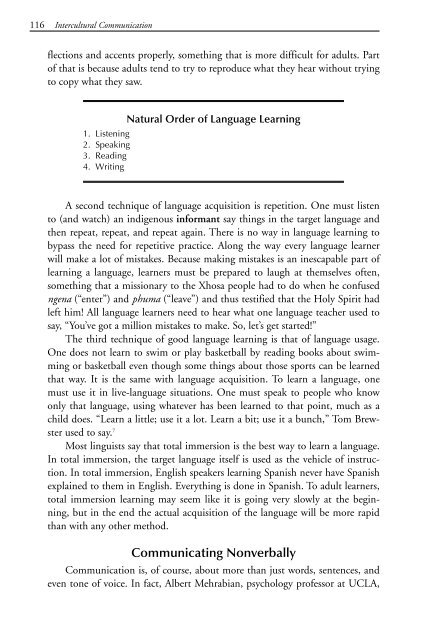discovering missions - Southern Nazarene University
discovering missions - Southern Nazarene University
discovering missions - Southern Nazarene University
You also want an ePaper? Increase the reach of your titles
YUMPU automatically turns print PDFs into web optimized ePapers that Google loves.
245187 Disc Missions ins 9/6/07 1:04 PM Page 116<br />
116 Intercultural Communication<br />
flections and accents properly, something that is more difficult for adults. Part<br />
of that is because adults tend to try to reproduce what they hear without trying<br />
to copy what they saw.<br />
1. Listening<br />
2. Speaking<br />
3. Reading<br />
4. Writing<br />
Natural Order of Language Learning<br />
A second technique of language acquisition is repetition. One must listen<br />
to (and watch) an indigenous informant say things in the target language and<br />
then repeat, repeat, and repeat again. There is no way in language learning to<br />
bypass the need for repetitive practice. Along the way every language learner<br />
will make a lot of mistakes. Because making mistakes is an inescapable part of<br />
learning a language, learners must be prepared to laugh at themselves often,<br />
something that a missionary to the Xhosa people had to do when he confused<br />
ngena (“enter”) and phuma (“leave”) and thus testified that the Holy Spirit had<br />
left him! All language learners need to hear what one language teacher used to<br />
say, “You’ve got a million mistakes to make. So, let’s get started!”<br />
The third technique of good language learning is that of language usage.<br />
One does not learn to swim or play basketball by reading books about swimming<br />
or basketball even though some things about those sports can be learned<br />
that way. It is the same with language acquisition. To learn a language, one<br />
must use it in live-language situations. One must speak to people who know<br />
only that language, using whatever has been learned to that point, much as a<br />
child does. “Learn a little; use it a lot. Learn a bit; use it a bunch,” Tom Brewster<br />
used to say. 7<br />
Most linguists say that total immersion is the best way to learn a language.<br />
In total immersion, the target language itself is used as the vehicle of instruction.<br />
In total immersion, English speakers learning Spanish never have Spanish<br />
explained to them in English. Everything is done in Spanish. To adult learners,<br />
total immersion learning may seem like it is going very slowly at the beginning,<br />
but in the end the actual acquisition of the language will be more rapid<br />
than with any other method.<br />
Communicating Nonverbally<br />
Communication is, of course, about more than just words, sentences, and<br />
even tone of voice. In fact, Albert Mehrabian, psychology professor at UCLA,

















